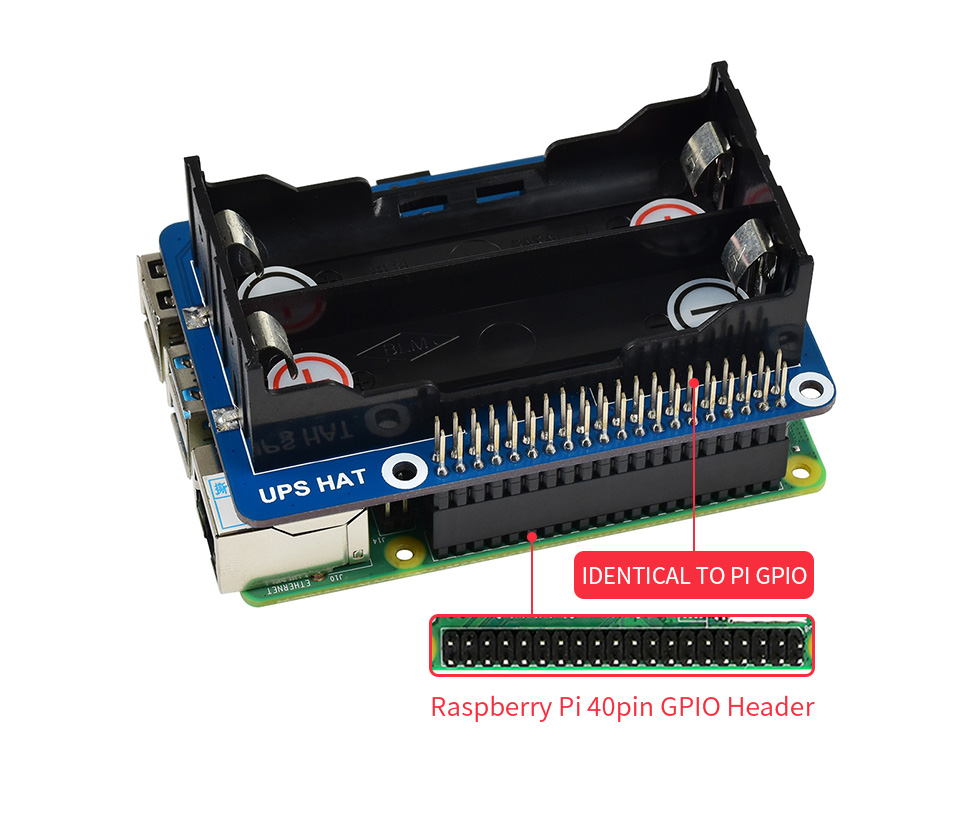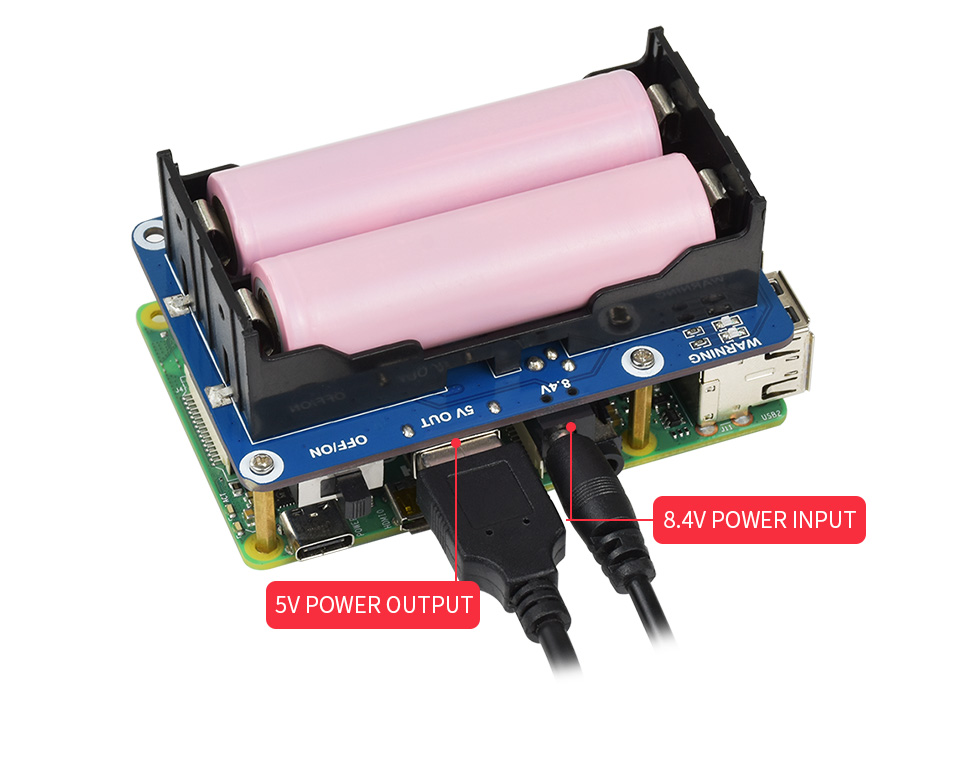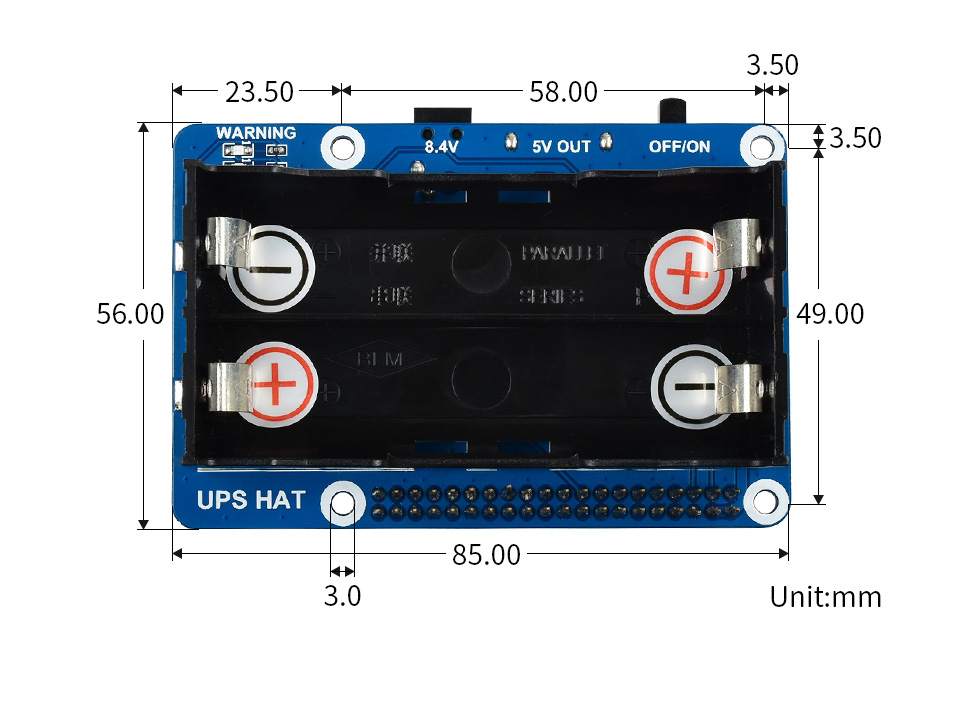
Module for using the WaveShare UPS Raspberry Pi Hat that has an embedded Texas Instruments INA219 sensor.
- Quick start
- Description
- Dependencies
- Documentation
- Coverage & Tests
- Examples
- Measurements
- Prior art
- Links to other NI modules
- Other links
- Roadmap
Create folder or add to existing code. Make sure to have package.json set to module if using imports instead of require. This lib is only tested with imports ie:
{
"main": "./index.js",
"type":"module",
"scripts": {
"start": "node ./index.js"
}
}add module:
yarn add @name-industry/ni-ina219in index.js copy this:
import NI_INA219 from "@name-industry/ni-ina219";
const formattedOutput = function (valueObject) {
if (valueObject.success === true)
return valueObject.data.valueString + " " + valueObject.data.valueType.short;
else {
return "Error getting result";
}
}
const initUPS = async function () {
// initialize the system
let started = await NI_INA219.initialize(0x42);
if (started.success === true) {
// DEBUG shows full return JSON object
// get the current active system configuration
let CONFIGURATION = await NI_INA219.getConfiguration();
console.log("CONFIGURATION", CONFIGURATION);
// get the current active calibration values
let CALIBRATION = await NI_INA219.getCalibration();
console.log("CALIBRATION", CALIBRATION);
// Shows quasi formatted result of measurement
// get the Bus voltage
let BUS_VOLTAGE = await NI_INA219.getBusVoltage();
console.log(" BUS VOLTAGE ", formattedOutput(BUS_VOLTAGE)); // load
// get the Shunt voltage
let SHUNT_VOLTAGE = await NI_INA219.getShuntVoltage();
console.log(" SHUNT VOLTAGE ", formattedOutput(SHUNT_VOLTAGE));
// get the Current in Milliamps
let CURRENT_AMPS = await NI_INA219.getCurrent();
console.log(" CURRENT MILLIAMPS ", formattedOutput(CURRENT_AMPS));
// get the Power in Watts
let POWER_WATTS = await NI_INA219.getPower();
console.log(" POWER WATTS ", formattedOutput(POWER_WATTS));
// PSU voltage - Custom calc for WaveShare Hat only
let POWER_SUPPLY_VOLTAGE = await NI_INA219.getPowerSupplyVoltage();
console.log(" POWER SUPPLY VOLTAGE ", formattedOutput(POWER_SUPPLY_VOLTAGE));
// Battery charge remaining - Custom calc for WaveShare Hat only
let CHARGE_REMAINING = await NI_INA219.getChargeRemaining();
console.log(" CHARGE REMAINING ", formattedOutput(CHARGE_REMAINING));
} else {
console.log("STARTED SENSOR ERROR", started);
}
}
initUPS();run from project terminal:
yarn startexample output for full json object. Note: [Array] is the default terminal output for nested objects. To see the full terminal results you would need to update terminal settings. In code you will get back the full object/array of course:
CONFIGURATION {
success: true,
msg: "Configuration",
data: {
register: "Configuration",
valueRaw: undefined,
valueString: undefined,
valueType: {},
extended: {
mappedLabelsAndBits: [Array],
registerAsBinaryString: "00111110 11101111"
}
}
}example output for quasi formatted results. Note: your results of course will vary ( values ) depending your device setup and battery charge:
BUS VOLTAGE 8.2360 V
SHUNT VOLTAGE -0.0195 mV
CURRENT MILLIAMPS -194.8000 mA
POWER WATTS 1.6020 W
POWER SUPPLY VOLTAGE 8.2045 V
CHARGE REMAINING 93 %
Uninterruptible Power Supply (UPS) for Raspberry PI. Allows for easily developing projects that could require emergency shutdown or logging during a power outage, giving extra run time when it is needed.
It uses an 8.4v adapter for charging and has space for 2x 18650 batteries. I was using 2 of these Panasonic NCR18650B for testing.
This hat is built and sold by WaveShare. The version this module is written for can be viewed/purchased here.
The hat uses an embedded INA-219 sensor for reading voltage, current and power along with the ability to set its system configuration to match the system its being installed for.
This module interacts specifically with the INA-219 on this hat.
Currently for using the example in the ./Example folder and to run tests via Jest, There is included the i2c-bus library found here. This module ( NI_INA219 ) is not meant to run on its own, but rather controlled via a parent application. Its more like an API exposing services and calls to other applications. When it is feature complete i2c-bus will be removed. Under normal situations the end user will provide the handle to the wire. BigJS deals with issues arising from toFixed in floating point conversions. Not really that much of a problem in this module but nice to have when we are rounding properly for UI displays.
| name | description | version |
|---|---|---|
| ic2-bus | NodeJs interface to the I2C bus | ^5.2.2 |
| big.js | Javascript lib to try and keep some fp precision | ^6.2.1 |
| name | description | version |
|---|---|---|
| node | using ES module/class constructs | >= 18 |
| jsDocs | for documentation of the module | ^3.6.11 |
| jest | for unit/integration testing | ^29.2.1 |
various other helper packages:
- "@babel/core": "^7.19.3",
- "@babel/preset-env": "^7.19.4",
- "babel-jest": "^29.2.1",
- "http-server": "^14.1.1",
- "jsdoc-template": "braintree/jsdoc-template",
- "jsdoc-to-markdown": "^7.1.1",
- "node-cleanup": "^2.1.2",
- "rimraf": "^3.0.2"
note: these are only required for developing this module and not for ingest of the module. More details around developing this module in section - ?
The module is fully documented with jsDoc within the source as well as the generated docs being included in the Repo. You can pull up the docs at anytime using the small server via Node / Yarn. Creating the docs again is also available.
Run this from console.
yarn docs-viewnote: when running the server if you are on a different platform ie: remote in via vsCode ssh, that the port forwarding needs to be working since the server boots local
Output is in ".Docs/NI-INA219". The html in Docs is kept for versioning and adding resources/documents that are persistent.
yarn docs-createRun this from console.
Currently the main NI_INA219 js file is running with tests and outputs coverage. The wrapper for the 3rd party Ic2-Bus module is mocked. The tests are only for returning the correct valid method result shape for data and errors. All methods pass around a value object for modularity.
yarn testRunning this will output coverage in the ./coverage folder by default. This will be hoisted into the ./Docs folder to be displayed alongside the main jsDocs.
Currently only the base example ( quick start is available ). Located in ./Example/index.js
The INA219 sensor uses these for measuring and then calculating the values.
The WaveShare UPS board has a 0.1 shunt Ohm resistor.
- Rshunt
- Current_LSB
This library builds on these two versions:
WaveShare's Python demo code
nodejs version by brettmarl on GitHub
Uses I2c-bus temporarily for developing - but will be removed once complete as the module should be provided a promise-based bus on instantiation.
| name | description | status | repo |
|---|---|---|---|
| NI-AM2315 | temperature / humidity i2c sensor | started | NI-AM2315 |
| NI-SHT30 | temperature / humidity i2c sensor | started | NI-SHT30 |
#note: regarding unit testing. I am not sure it will be 100% coverage ever as dealing with hardware there is potential problems with hitting it with totally incorrect values unless I mock up the board 100% which I would rather not do. ( Much rather be making a soft-synth than mocking up a voltage meter )
- externalize the I2c bus for injection instead of default
- add in default logger for example to show injection - PinoJS
- add in architecture docs/charts ( the why of the folders/code structure )
- make configuration templates external and loadable json files
- expose system calculations to better work with PI
- fix jsDoc Docs generation and local serving
- complete Docs to 100%
- set up coverage for return DTO values of all public methods, currently is not 100%
- refactor for unit testing of internal methods currently 0% coverage
- implement triggered mode
- implement single trigger modes
- implement single continuous modes
- expose Configuration register as much as is viable
- expose Calibration register as much as possible
- namespace ina219 sensor methods and extended WaveShare board methods so that I can use this lib without the UPS in case I need to.
- sadly -> the list can go on...........







